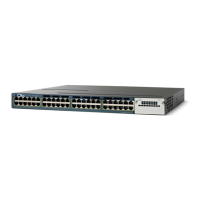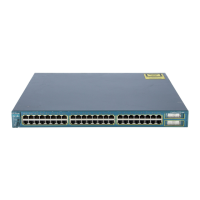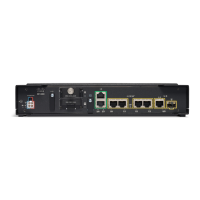1-20
Catalyst 3750-X and 3560-X Switch Software Configuration Guide
OL-25303-03
Chapter 1 Configuring IPv6 Unicast Routing
Configuring IPv6
Configuring an IPv6 Snooping Policy
Action or Command Purpose
Step 1
enable Enables privileged EXEC mode. Enter your password if prompted.
Step 2
configure terminal Enters the global configuration mode.
Step 3
ipv6 snooping policy policy-name Creates a snooping policy in global configuration mode.
Step 4
[data-glean | default | device-role [node
| switch] | limit {address-count value }|
no | protocol [all | dhcp | ndp] |
security-level [glean | guard | inspect]|
tracking [disable | enable]|
trusted-port}
Enables data address gleaning, validates messages against various
criteria, specifies the security level for messages.
• (Optional) data-glean—Enables data address gleaning. This option
is disabled by default.
• (Optional) default—Sets all default options.
• (Optional) device-role [node | switch]—Qualifies the role of the
device attached to the port.
• (Optional) limit {address-count value}—Limits the number of
addresses allowed per target.
• (Optional) no—Negates a command or set its defaults.
• (Optional) protocol [all | dhcp | ndp]—Specifies which protocol
should be redirected to the snooping feature for analysis. The default,
is all. To change the default, use the no protocol command.
• (Optional) security-level [glean | guard | inspect]—Specifies the
level of security enforced by the feature.
–
glean—Gleans addresses from messages and populates the
binding table without any verification.
–
guard—Gleans addresses and inspects messages. In addition, it
rejects RA and DHCP server messages. This is the default
option.
–
inspect—Gleans addresses, validates messages for consistency
and conformance, and enforces address ownership.
• (Optional) tracking [disable | enable]—Overrides the default
tracking behavior and specifies a tracking option.
• (Optional) trusted-port—Sets up a trusted port. It disables the guard
on applicable targets. Bindings learnt through a trusted port have
preference over bindings learnt through any other port. A trusted port
is also given preference in case of a collision while making an entry
in the table.
Step 5
exit Exits the snooping policy configuration mode.
Step 6
show ipv6 snooping policy policy-name Displays the snooping policy configuration.

